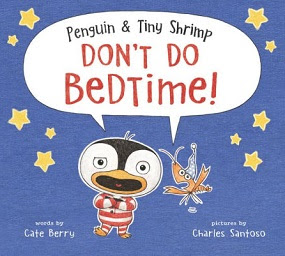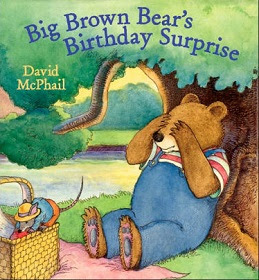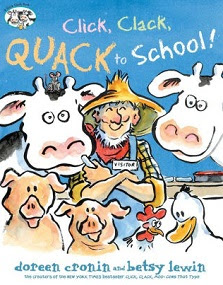Bedtime Resistors--UNITE! Penguin and Tiny Shrimp DON'T DO BEDTIME! by Cate Berry
"THIS BOOK WILL NEVER MAKE YOU YAWN."
Penguin and his sidekick Tiny Shrimp may be dressed to doze, but don't be fooled by their clothes. Sure, Penguin is rockin' his stripey PJs and Tiny Shrimp's got his nightcap at a jaunty angle, but that doesn't mean that nighty-night snoozin' is part of their plan.
Forget it with the bubbly tub and the yellow rubber ducky. Kick the cushy bed and poofy pillow. Penguin and Tiny Shrimp are pullin' an all-nighter!
"YOU WON'T CATCH US WITH SLEEPY SHEEP OR WISHING STARS.
SAYONARA, SHEEP!"
No way these two are gonna hit the hay. The two bedtime resistors decide to try the scene on the Serengeti savanna for a run with the lions, and go for a rumble in the jungle. swinging with the monkeys on their vines. They board a boat and float into the deep sea to sail with the sharks.
Penguin can't resist doing a little stand-up to see if his anti-sleep co-conspirator is still on his toes:
"TINY SHRIMP! WHAT DO YOU CALL A FISH WITH TWO KNEES?"
"A TUNEE FISH!"
By this time they've acquired quite a retinue--a water buffalo, a lion, a uni-hippo, and an octopus--but by now, even the fireworks aren't keeping their eyelids from drooping, and the uni-hippo is yawning. And since he's the last one standing, he gets the last line.
THIS BOOK WILL SEE YOU IN THE MORNING!!
Cate Berry's brand-new Penguin & Tiny Shrimp Don't Do Bedtime!
And a rowdy and comic romp it is. With the story told in speech balloons, noted artist Charles Santoso takes up the challenge to keep this story moving all the way to the final page--in which nature has its way with Berry's lovable little bedtime dissenters and all comes to rest. "A buoyantly subversive antibedtime tale," says Publishers Weekly.
Labels: Bedtime Stories, Sleep--Fiction (Grades Preschool-3)





















